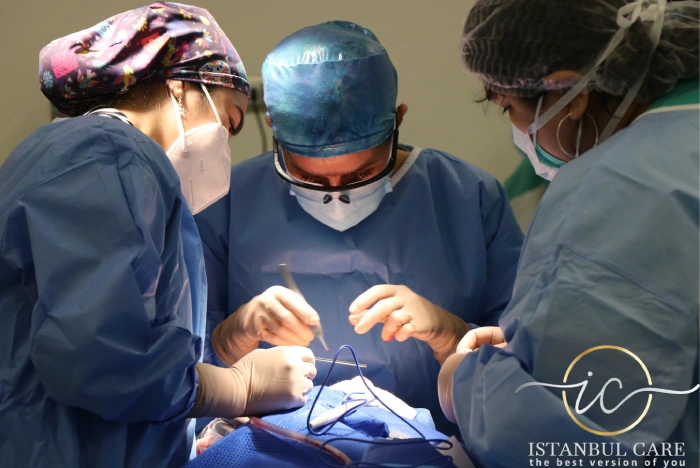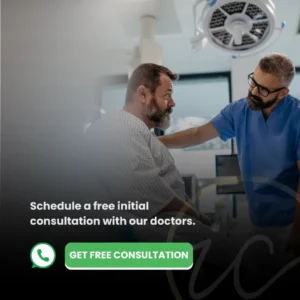Sleeve gastrectomy, commonly known as gastric sleeve surgery, is a popular weight loss procedure in Turkey. This surgery involves reducing the stomach’s size to help individuals achieve significant weight loss. Turkey has become a preferred destination for this procedure due to its experienced surgeons and affordable healthcare services.
What Is the Gastric Sleeve?
The gastric sleeve, or sleeve gastrectomy, is a surgical method designed to aid weight loss by removing approximately 80% of the stomach. This reduction limits food intake and decreases appetite, facilitating weight loss.
How Does the Gastric Sleeve Procedure Work?
During the surgery, a large portion of the stomach is removed, leaving a tube-like structure. This smaller stomach holds less food and produces fewer hunger-inducing hormones, promoting weight loss.
Benefits of the Sleeve Gastrectomy Weight Loss Surgery
- Significant Weight Loss: Patients often lose a substantial amount of excess weight within the first year.
- Improved Health Conditions: Conditions like type 2 diabetes and high blood pressure may improve or resolve.
- Enhanced Quality of Life: Many individuals experience increased mobility and self-esteem.
Am I a Candidate for Sleeve Gastrectomy Surgery?
Ideal candidates for sleeve gastrectomy typically have a Body Mass Index (BMI) of 40 or higher, or a BMI of 35 with obesity-related health issues. A thorough medical evaluation is necessary to determine suitability.
Requirements for Sleeve Gastrectomy Surgery
- Age: Generally between 18 and 65 years old.
- Previous Weight Loss Attempts: Demonstrated efforts through diet and exercise without sustained success.
- Commitment: Willingness to adhere to post-surgery lifestyle changes and follow-up appointments.
How Is a Sleeve Gastrectomy Performed?
The procedure is performed laparoscopically under general anesthesia. Small incisions are made in the abdomen to insert surgical instruments and remove a portion of the stomach. The surgery typically lasts about 1-2 hours.
What Kind of Anesthesia Is Used for a Sleeve Gastrectomy?
General anesthesia is administered, ensuring the patient remains unconscious and pain-free during the operation.
What Are the Risks of a Sleeve Gastrectomy?
While generally safe, sleeve gastrectomy carries potential risks:
- Surgical Complications: Bleeding, infection, or adverse reactions to anesthesia.
- Long-term Issues: Nutrient deficiencies or gastrointestinal problems.
Discussing these risks with a healthcare provider is essential before proceeding.
What Is Recovery Like After a Sleeve Gastrectomy?
Recovery involves a hospital stay of 2-3 days, followed by gradual reintroduction of foods over several weeks. Patients are advised to avoid strenuous activities for about a month and attend regular follow-up appointments to monitor progress.
Aftercare and Recovery
- Dietary Changes: Starting with liquids, then pureed foods, and eventually solid foods.
- Physical Activity: Light activities initially, gradually increasing as tolerated.
- Monitoring: Regular check-ups to assess weight loss and nutritional status.
How Much Weight Will I Lose with a Sleeve Gastrectomy in Turkey?
On average, patients lose about 60-70% of their excess weight within two years post-surgery. Individual results may vary based on adherence to lifestyle changes and personal health factors.
How Long Will the Benefits of a Sleeve Gastrectomy Last?
With proper diet and exercise, the weight loss and health benefits can be long-lasting. Continuous medical follow-up is crucial to maintain these outcomes.

How Safe Is Gastric Sleeve Surgery in Turkey?
Turkey is renowned for its qualified surgeons and modern medical facilities. Many clinics are internationally accredited, ensuring high standards of care. However, it’s vital to research and choose a reputable clinic.
Successful Gastric Sleeve with Comprehensive Care
Opting for clinics that offer comprehensive pre-operative assessments and post-operative support enhances the likelihood of a successful outcome.
How Much Does Sleeve Gastrectomy Surgery Cost in Turkey?
The cost of sleeve gastrectomy in Turkey is significantly lower than in many Western countries, ranging from €3,500 to €5,500. Prices may vary based on the clinic and included services.
Factors Influencing Cost
- Surgeon’s Experience: Highly experienced surgeons may charge more.
- Facility Quality: State-of-the-art facilities might have higher fees.
- Included Services: Some packages cover accommodation, transfers, and post-operative care.
Standard Packages
For Sleeve Gastrectomy in Turkey, you will stay 2 nights in the hospital + 4 nights in a VIP hotel
- Accommodation in a VIP hotel
- All transfers between the airport and hotel with a VIP car
- All internal transfers between the hotel and hospital
- Medical consultation and examination
- Preoperative evaluation and tests
- Private hospital room for the nights of the procedure
2 follow-up appointments with the doctor after the procedure
- Anesthesia
- Nursing care facilities
- Medical equipment
- Medications
- Post-operative check-up and post-operative instructions
- Final check-up before departure
- Lifetime assistance
Density Boost
- Consultation & Hairline planning by Our Plastic Surgeon
- DHI or Sapphire FUE hair transplant surgery after an online consultation with a consultant
- 1. Day: The SVF stem cell treatment, which is performed by extracting from the abdomen, is carried out by pur plastic surgeon (stem cell hair treatment using abdominal fat, which has more stem cells boosts hair growth density.)
- 2. Day: Operation is done by a team of Hair Transplant Specialists under the supervision of our Plastic Surgeon
- Exsome Hair Therapy to stimulate hair growth and improve scalp health
- Prp ( One session)
- Laser hair regrowth treatment (one session.) FDA-approved laser devices for treating pattern hair loss and androgenic alopecia are available exclusively at Este Medical Group.
- Sedation ( No pain during the numbing process)
- Blood tests
- All the required medications
- 6-month Aftercare supplements
- 5-star Hotel Accommodation (3 Nights)
- Check up and first wash on the following day
- Travel Health Insurance: Travel confidently—protect your hair transplant journey. Stay covered for any illness or injury abroad.
- Personal translator available at all times
- Airport and internal transfers
- 12 months of online post-operation follow-ups.
What Are the Advantages of the Gastric Sleeve Approach?
- No Foreign Objects: Unlike gastric banding, no implants are used.
- Preservation of Digestive Function: The digestive tract remains intact, reducing the risk of malabsorption.
- Reduced Hunger: Lower levels of hunger hormones decrease appetite.
Is Gastric Sleeve Right for Me?
If you’ve struggled with obesity and related health issues, and other weight loss methods haven’t worked, gastric sleeve surgery might be a viable option. Consulting with a healthcare professional can provide personalized guidance.
Vertical Sleeve Gastrectomy: An Overview
Vertical sleeve gastrectomy is another term for gastric sleeve surgery. It involves creating a sleeve-shaped stomach to restrict food intake, leading to weight loss.
Why the Procedure Is Performed
This surgery is performed to help individuals lose weight and reduce the risk of obesity-related health problems, such as heart disease, diabetes, and hypertension.
What Are the Goals of a Sleeve Gastrectomy?
Sleeve gastrectomy aims to:
- Promote Long-Term Weight Loss – Helps patients achieve sustainable weight reduction.
- Improve Obesity-Related Health Conditions – Reduces risks of type 2 diabetes, hypertension, and sleep apnea.
- Enhance Quality of Life – Increases mobility, energy levels, and self-confidence.
Patients who follow a healthy lifestyle post-surgery experience the most long-lasting results.

Speak with our expert Sleeve Gastrectomy specialists
We’re ready to answer your questions

What Are the Goals of a Sleeve Gastrectomy?
Sleeve gastrectomy aims to:
- Promote Long-Term Weight Loss – Helps patients achieve sustainable weight reduction.
- Improve Obesity-Related Health Conditions – Reduces risks of type 2 diabetes, hypertension, and sleep apnea.
- Enhance Quality of Life – Increases mobility, energy levels, and self-confidence.
Patients who follow a healthy lifestyle post-surgery experience the most long-lasting results.
Risks of Sleeve Gastrectomy Surgery
Like any surgical procedure, sleeve gastrectomy carries some risks.
Short-Term Risks:
✔ Bleeding & Infection – Rare but manageable with proper post-op care.
✔ Nausea & Vomiting – Common in the first few weeks as the stomach adjusts.
✔ Blood Clots – Preventable with movement and compression garments.
Long-Term Risks:
✔ Acid Reflux – Some patients may develop heartburn.
✔ Nutrient Deficiencies – Proper supplementation helps prevent this.
✔ Weight Regain – Lifestyle adjustments are essential to maintain results.
Choosing a qualified surgeon in Turkey minimizes risks and ensures a safe procedure.
What to Expect After a Sleeve Gastrectomy?
✔ First 24 Hours – Patients are monitored for complications.
✔ First Week – Strict liquid diet and minimal activity.
✔ Weeks 2-4 – Introduction of pureed and soft foods.
✔ After 1 Month – Regular foods are reintroduced in small portions.
Regular follow-ups with the surgical team are crucial for a successful recovery.
Aftercare and Recovery for Gastric Sleeve Patients
✔ Dietary Guidelines – Gradual transition from liquids to solid foods.
✔ Physical Activity – Light exercise after a few weeks to aid recovery.
✔ Hydration – Drinking enough water prevents dehydration.
Following a structured aftercare plan ensures optimal weight loss results.

Frequently Asked Questions
The cost ranges from $3,300 to $5,500, depending on the clinic and services included.
The surgery typically lasts 1-2 hours, followed by a 2-3 day hospital stay.
Most patients lose 60-70% of their excess weight within 12-24 months.
Yes, if patients maintain a healthy lifestyle, they can sustain long-term results.
Most insurance plans don’t cover bariatric surgery abroad, but some Turkish clinics offer financing options.
Patients with diabetes, hypertension, or sleep apnea may qualify, but a medical evaluation is required.
Turkey offers high-quality healthcare, experienced surgeons, and affordable prices, making it a top choice for medical tourists.








